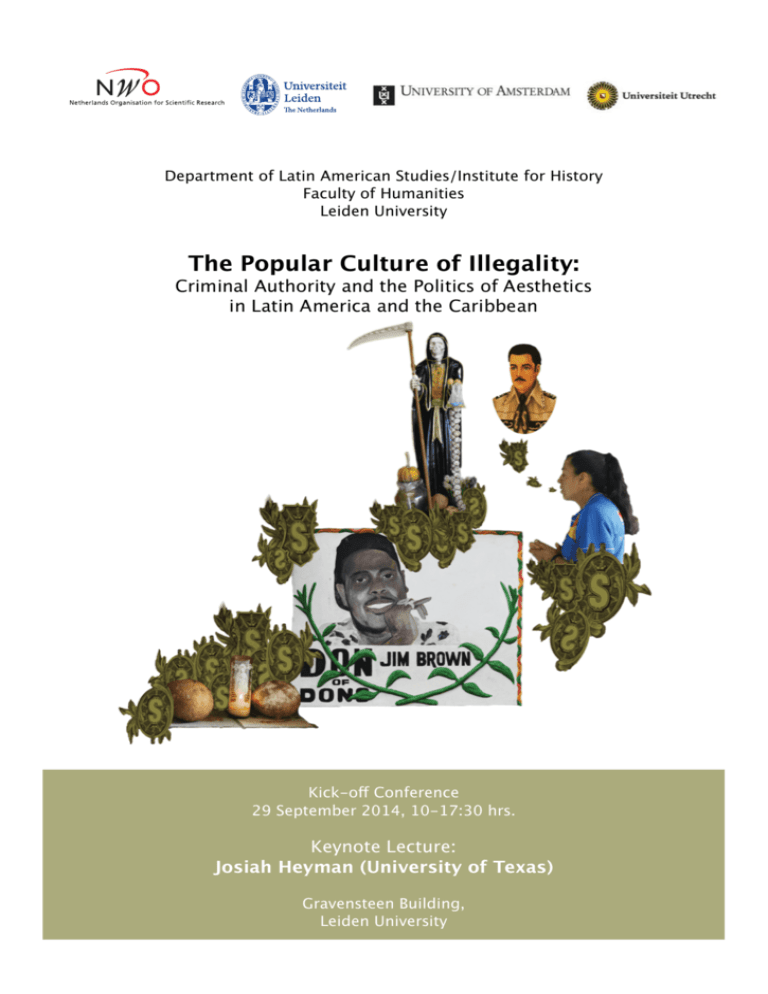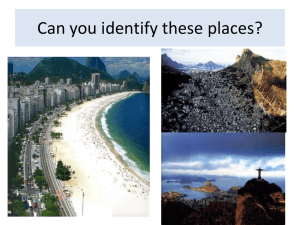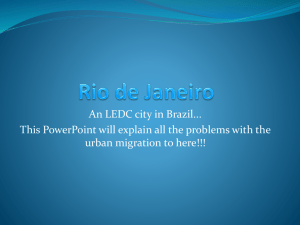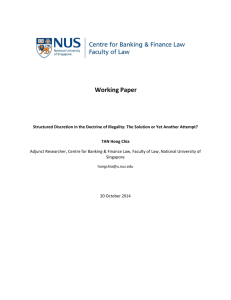Pop Cult Conference 2014 Announcement
advertisement

! ! ! ! ! ! Department of Latin American Studies/Institute for History Faculty of Humanities Leiden University The Popular Culture of Illegality: Criminal Authority and the Politics of Aesthetics in Latin America and the Caribbean ! ! ! ! ! ! ! ! ! ! ! ! ! ! ! ! ! ! ! ! Kick-off Conference 29 September 2014, 10-17:30 hrs. ! Keynote Lecture: Josiah Heyman (University of Texas) ! Gravensteen Building, Leiden University ! ! ! Culture is a powerful resource in political attempts to win and withhold legitimacy. National states have historically made use of religion, visual expressions and mythical narratives to nurture consent and pursue domination. Since the 1990s, criminal actors have expanded their presence all throughout the Latin American and the Caribbean. Drug lords, among other illegal actors, often provide state-like services, asserting their authority through the use of violence but also by employing cultural means in highly excluded or marginalised communities. Within this context, culture (re)produces the socio-political authority of gangs and cartels. The lyrics and rhythms of baile funk music in favelas in Rio de Janeiro are a resource that co-defines the identity of drug dealers. In Kingston, the use of graffiti and street art more broadly has created an iconography through which dons (criminal leaders) have become accepted and even celebrated. The emerging cult of Santa Muerte, in Mexico, elusively exposes the world of drugs and human trafficking to dominant society, influencing perceptions of legitimacy and institutional power. Funded by the Netherlands Organisation for Scientific Research (NWO), the research project The Popular Culture of Illegality (2013-2018), led by Dr. Rivke Jaffe and Dr. Martijn Oosterbaan, will study the material and immaterial culture that constitutes the aesthetics and legitimation of criminal authority. Through which aesthetic practices are people mobilized to accept and support criminal authority? How is the popular culture of illegality central to forms of governmentality? How do visuality, aurality and materiality work to constitute and legitimate authority? In this first symposium of a conference series, the research group presents the theoretical and empirical contexts that constitute the overarching research program. The presentations will illustrate the different locations and case studies, which include Brazil, Jamaica and Mexico. ! Programme Overview, 29 September 2014 ! 10:00 Welcome by Prof.Dr. Wim van der Doel, Dean of the Faculty of Humanities, Leiden University ! The Popular Culture of Illegality (presentation research project) Dr. Rivke Jaffe (University of Amsterdam) and Dr. Martijn Oosterbaan (Utrecht University) ! “Tropa de Elite”: A Spectacle of Police Practices, Illegalities and State Violence in Rio de Janeiro Dr. Carly Machado (Federal Rural University of Rio de Janeiro) ! The Painted Heroes in Kingston Dr. Petrina Dacres (Edna Manley College for the Visual and Performing Arts, Jamaica) ! 12:30 Lunch ! 14:00 Presentations Research Projects Cultures of Illegality: Criminality and Popular Religiosity in the Devotion to Santa Muerte in Mexico Dr. José Carlos G. Aguiar (Leiden University) ! “He was a world boss”: Visual Culture and the Legitimation of Donmanship in Inner-City Jamaica Tracian Meikle (University of Amsterdam) ! The Body and the Beat. Baile Funk in the Favelas of Rio de Janeiro Sterre Gilsing (Utrecht University) ! Comments by Prof.Dr. Manon van der Heijden (Leiden University) ! 16:00 Keynote Lecture The Socio-Political Construction of Legality and Illegality Prof.Dr. Josiah Heyman (University of Texas at El Paso) ! Comments by Prof.Dr. Henk te Velde (Leiden University) ! 17:30 Closing words by Prof.Dr. Patricio Silva, Director Department of Latin American Studies, Leiden University ! Drinks ! ! Location ! Gravensteen Building Pieterskerkhof 6 2311 SR Leiden, the Netherlands Click here for map ! ! Registration ! Please register by email until 22 September at: ! cultureillegality@icloud.com ! ! ! Organisation ! Dr. José Carlos G. Aguiar, Leiden University j.c.g.aguiar@hum.leidenuniv.nl ! ! Website ! For further information regarding the research group and ongoing projects, consult: ! https://vre.leidenuniv.nl/vre/cultureofillegality/SitePages/Home.aspx Keynote Lecture The Socio-Political Construction of Legality and Illegality Prof.Dr. Josiah Heyman, University of Texas at El Paso ! A first approach to topics involving illegality, such as “The Popular Culture of Illegality,” is to ask about the socio-political construction of legal and illegal. Illegality is an act against (and thus because of) a specific legal order. Legalization and illegalization processes are thus key, and demand thoughtful, critical study. They are socio-political projects developed over time, with both meaningful and material components (e.g., legal language and enforcement apparatuses). As projects, they occur within but recursively modify power fields. It is useful to view them as projects in social and cultural fields that take place with considerable struggle and contingency over historical time, rather than static discursive arrangements or material systems to be decoded. States and interstate entities may appear to have “failed,” in part or whole, in enforcing laws--indeed the limits of dominant legal regimes are important to consider—but prior to questions of state failure or incompleteness are questions about the constitutive processes of “illegality” and “legality” as such. Normative values do and should matter to considerations of legality and illegality, but there is no absolute normative standpoint above and outside historical projects, but rather debates over values that emerge within legalization and illegalization processes. Examples are drawn from legal and illegal drugs, and legal and illegal migration, between Mexico and the United States. ! ! Abstracts Conference Papers Cultures of Illegality: Criminality and Popular Religiosity in the Devotion to Santa Muerte in Mexico Dr. José Carlos G. Aguiar, Leiden University j.c.g.aguiar@hum.leidenuniv.nl ! Since the early 2000s, shrines and chapels devoted to Santa Muerte, the skeleton saint, have mushroomed all across Mexico. The image resembles the virgin Mary, and it blends pre-Hispanic representations of the mother earth and the underworld, together with elements of the Catholic iconography, heavy-metal influences, santería (African/Cuban magic), and the lifestyle of drug-traffickers. Until the 1990s, Santa Muerte was believed to be the protector of satanists and drug barons, and the cult was clandestine. However, in the current context of expanding violence in Mexico, the Santa Muerte has ‘came out from the dark’, and turned into a popular saint widely visible in marketplaces, streets and ‘sanctuaries’ specially built for her veneration in extremely marginal or violent neighborhoods. In Mexico City, Guadalajara and Puebla ‘churches’ have been erected where Santa Muerte is (semi)publicly worshipped. This new form of religious belief synthesises the ongoing security crises and implosion of institutional life in Mexico. In this paper, ethnographic material is presented in order to analyse the cultural resources through which Santa Muerte devotion expands, against the larger Latin American context where popular saints loom out of the world of criminality. ! ! The Painted Heroes in Kingston Dr. Petrina Dacres, Edna Manley College for the Visual and Performing Arts, Jamaica lulu_dacres@hotmail.com ! In September 2011 the government of Jamaica sought to reconvene the advisory committee to examine individuals who may be bestowed The Order of National Hero, the nation’s highest honour. These practices have demonstrated the spectacular ways in which the state created a national past and positioned its future self. While the state has been reluctant to commemorate new National Heroes, residents of urbanised communities have developed their own forms of remembrance of local heroes and other members of their neighbourhood that have passed away. Indeed, throughout Jamaica’s cityscapes, there has been a growing presence of painted portraits of deceased youths on walls and bus stops, for example. This new commemorative practice references the state’s pantheon project of constructing public memory through the male body but differs in terms of media and, enlarges the idea of the ‘hero.’ Indeed, the pantheon of painted portraits includes individuals involved in the qausi-parallel systems of governance that control many of Jamaica’s poor and urbanised communities, partly through fear and intimidation. The paper introduces us to the aesthetic terms by which death is commemorated in Jamaica. Using the wall portraits as its focus, the paper, moreover, surveys the relationship between masculinity, history, and visuality in contemporary Jamaica. ! ! The Body and the Beat. Baile Funk in the Favelas of Rio de Janeiro Sterre Gilsing, Utrecht University S.E.Gilsing@uu.nl ! In Rio de Janeiro, favela life is deeply intertwined with highly violent and sexualized baile funk music. This paper focuses on the production of aesthetic knowledge by, through and in bodies of favela inhabitants who make, listen to, and dance to funk. I will examine how this knowledge influences the legitimation and authority of illegal forces in favelas. Studying this process closely will illuminate how power processes work in relation to music and how music produces aesthetic values through which the way of life in favelas is normalized for its residents. The bodies of favelados are an especially fit terrain to study funk music, because through their bodies, people express themselves and make sense of funk during bailes. To develop a view on the unique emotional intensity of music and the embodied knowledge generated by it, I will use sensorial fieldwork. Paying attention to the senses will give me an insight in the sensorial understandings and sonic politics in the favela. ! ! “Tropa de Elite”: A Spectacle of Police Practices, Illegalities and State Violence in Rio de Janeiro Dr. Carly Machado, Federal Rural University of Rio de Janeiro (UFRRJ) machado.carly@gmail.com ! The Brazilian movie “Tropa de Elite” (Elite Squad, 2007) deals with urban violence in Rio de Janeiro through the life of Captain Nascimento, colonel of the Batalhão de Operações Especiais da Polícia Militar. Captain Nascimento performs extremely violent and illegal action on behalf of the state, and the character quickly became a sensation in Brazil. Nascimento points to a deep-seated ambiguity with regard to police violence among Brazilian citizens: people perceive the police as untrustworthy and dangerous, but also arguably believe that only police cruelty can eradicate evil. In this paper, I discuss how these tropes and symbols interact and merge with the religious field, by focusing on the emergence of an evangelical music band “Tropa de Louvor” (Praise Squad), formed by evangelical police employees. The Praise Squad band is commonly presented as one of the “social projects” of the military police of Rio de Janeiro and in that guise it has performed in several of Rio's favelas. An analysis of the film in relation to the band and the legal/illegal actions of police forces in Rio demonstrates how different modes of governmentality clash, interact and merge in particular articulations of popular culture, religion and the practices of the state in Brazil. ! ! “He was a world boss”: Visual Culture and the Legitimation of Donmanship in Inner-City Jamaica Tracian Meikle, University of Amsterdam T.A.Meikle@uva.nl ! Criminal leaders known as 'dons’ have been the de facto rulers of many communities in inner- city Jamaica for over forty years, and their authority is reflected in different forms of visual culture that are spread throughout the inner city, such as murals that pay tribute to both living and deceased dons. These visual testaments of donmanship will be explored in this paper through ethnographic fieldwork in inner-city Jamaica, and critical aesthetic analysis of the different visual elements. This will lead to an understanding of their role in the lived experience of the residents and how they function as modalities that mediate between residents and the larger system of don-led rule, thus providing further insight into the role of visual culture in the shaping of the urban space and the negotiation of urban citizenship and governance.







